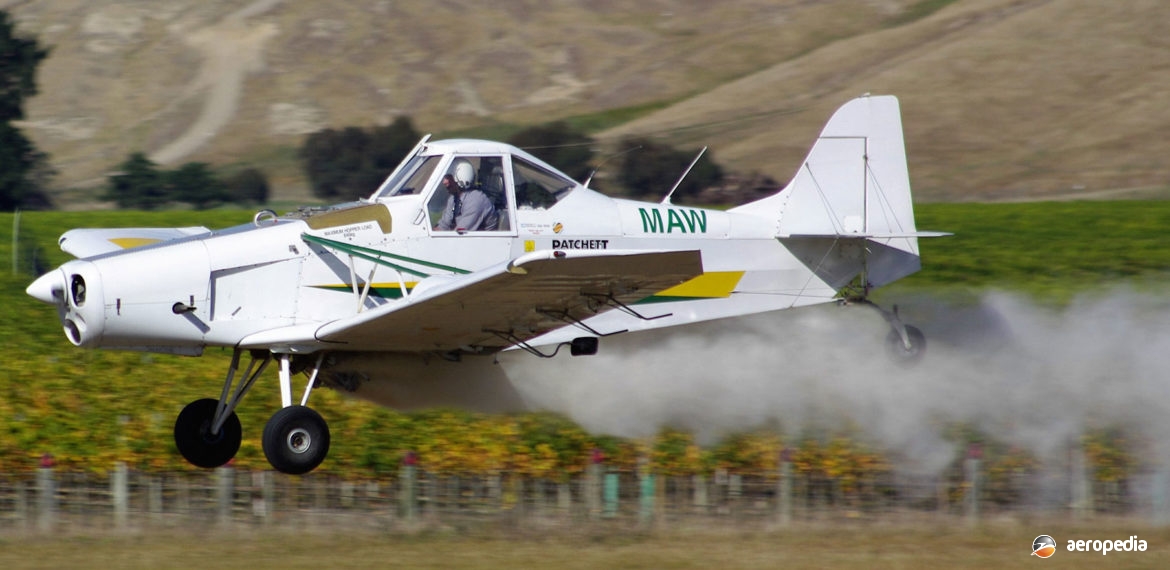Photograph:
GippsAero GA-200 ZK-MAW (c/n 200-9721) at Omaka, NZ in April 2003 (David C Eyre)
Country of origin:
Australia
Description:
Two-seat agricultural monoplane
Power Plant:
One 186 kw (250 hp) Lycoming O-540-H2A5 or O-540-A1D5 six-cylinder horizontally-opposed air-cooled engine
Specifications:
- Wingspan: 11.98 m (39 ft 3¾ in)
- Length: 7.48 m (24 ft 6½ in)
- Height: 2.33 m (7 ft 7¾ in)
- Wing area: 19.59 m² (210.9 sq ft)
- Never exceed speed: 266 km/h (165 mph)
- Max cruising speed at 75% power: 213 km/h (132 mph)
- Cruising speed at 305 m (1,000 ft): 185 km/h (115 mph)
- Stalling speed flaps up: 108 km/h (67 mph)
- Stalling speed flaps down: 99 km/h (61 mph)
- Max rate of climb at sea level: 290 m/min (950 ft/min)
- Landing run: 360 m (1,181 ft)
- Max range: 760 km (460 miles)
- G limits: +3.8/-1.52
- Empty weight: 758 kg (1,671 lb)
- Operating weight: 868 kg (1,914 lb)
- Max hopper capacity: 544 kg (1,199 lb)
- Loaded weight [normal category]: 1,524 kg (3,359 lb)
- Loaded weight [agricultural]: 1,995 kg (4,398 lb)
Take-off run: 350 m (1,148 ft)
Take-off distance over 15 m (50 ft) obstacle: 475 m (1,558 ft)
History:
For some years Gippsland Aeronautics (formerly Latrobe Valley Aviation Services) was involved in rebuilding the Piper PA-25-235 Pawnee agricultural aircraft. Two aircraft were rebuilt with modified fuselages and became known as the PA-25-235A-8, the first being c/n 25-2490, which became VH-GWS on 5 September 1980, later becoming VH-NLP on 17 May 1984.
The Company then designed a new wing and these aircraft became known as the PA-25-235A-9, these commonly becoming known as the A-9 Fatman. First aircraft with the new wing was VH-AMZ (c/n 25-3472), which became VH-GWS. It was followed by VH-NLP (c/n 25-3024) on 17 May 1984; VH-GWS (c/n 25-2490) in December 1986; and VH-SPE (c/n 25-4249), all retaining the Pawnee tail and the fuel tank between the hopper and the engine. Hopper capacity initially was 776 litres (170 Imp gals).
In August 1990 a new aircraft was registered VH-BCE (c/n 200-9101) as the Gippsland GA-200 and this featured a new distinctive tailplane. Subsequently the type entered production with the 186 kw (250 hp) engine, this eventually being superseded by the 224 kw (300 hp) variant which became known as the GA-200C. The GA-200B was an unofficial designation for a model with extended wingtips and most aircraft completed up to 1998 were to this standard. The GA-200C had a Lycoming IO-540K1A5 engine with a revised cowling and a constant-speed propeller. Hopper capacity was 1,050 litres (231 Imp gals). In early 1998 the 21st production aircraft (which was the 23rd aircraft completed) became the GA-200C prototype. Subsequent aircraft from number 45 had the Textron Lycoming AEIO-580 engine of 246 kw (330 hp), this model flying for the first time on 11 February 2003 and retaining the GA-200C designation.
The type was exported to Brazil, Canada, China (9), New Zealand (8), South Africa and the United States. It was a purpose-designed agricultural aircraft with a braced low-wing and a large integral hopper forward of the cockpit. Structure was of welded SAE 4130 chromoly steel tube with removable side panels. The tail surfaces were of conventional all-metal structure and the wing spars were constructed from sheet metal to allow for quick repair. Seating was for two, side-by-side, the smaller right-hand seat for the loader / driver. Dual controls and a second set of rudder pedals were installed in the Agtrainer variant.
The GA-200 received full Type Certification in March 1991, the first of the type being flown in 1990. The Fatman A-9 received a supplementary Type Certificate, five being produced, including VH-AMZ (c/n 25-3472) and VH-SPE (c/n 25-4249) before production switched to the new type. Differences from the Pawnee included a new tail fin; two-seat side-by-side configuration; an all-metal wing, this improving the aerodynamics and handling; and larger flaps. The aircraft could spread chemicals or fertilisers at the rate of 9,144 kg (20,160 lb) per hour. The Company also did some work with a view to developing a Chevrolet V-8 automotive engine for installation in the Pawnee, an example being converted and flown in early 1990, the liquid-cooled engine providing a considerable saving in initial cost, fuel costs and overhaul expenses.
The first GA-200 was VH-BCE (c/n 200-9101) registered to an operator in Innisfail, QLD on 11 April 1991. Two variants were available, the Standard version with the optional 0.7 m (2ft 6 in) wingtip extensions for short-field operations; and the Ag-trainer, a training version with dual controls, dual rudder pedals, and a smaller hopper. Production continued at a slow rate with orders for more than 50 examples completed.
In late 1994 nine examples were delivered to China where they were operated by the Agricultural Aviation Experimental Station, and discussion proceeded relating to licence production in China. In late 2014 the Chinese Civil Aircraft Register showed at least six surviving in service, these including B-8512 – c/n 9203; B-8513 – c/n 9304; B-8515 – c/n 9306; B-8517 – c/n 9408; B-8519 – c/n 9411; and B-8520 – c/n 9412.
First of the type registered in New Zealand was ZK-CMC (c/n 2009413) in 1994. In July 2016 VH-SZV (c/n 200C 9831) was flown from Australia to New Zealand, where it became ZK-DPC with Patchett Ag Air 2015 Ltd.

